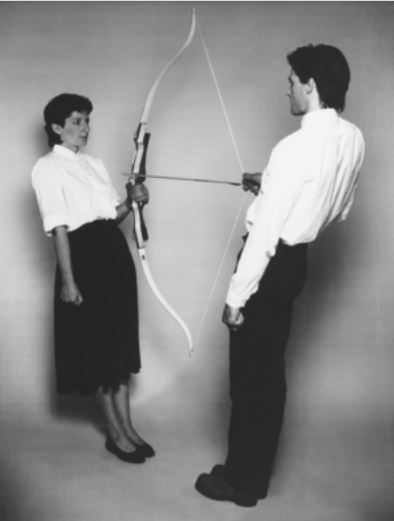Marina Abramovic and Performance Art
Written by: Anna Groninger
Until the 1970s, “performance art” wasn’t a visual art term. However, the idea existed decades before the term became widely known. This type of visual art often speaks out against social injustice, or conveys a message through spectacle. The term “performance art” includes mediums such as video and photography, and is now a recognized form of visual art in the art world.
Playing an important role in movements such as Futurism and Dadaism, performance art challenges traditional forms of art such as painting and drawing by using the body more than the materials. The artist becomes the art. If an artist grew tired of using traditional materials to create art, she might turn to performance art in search of something new and exciting (or even dangerous, depending on the artist’s risk tolerance).
How could art be dangerous? Marina Abramovic’s “Rhythm 0” made in 1974 is a great example of risk-taking in performance art. Abramovic, Godmother of Performance Art, set up a table in Studio Morra in Naples, and invited viewers to engage with her and with several quotidian items. There were pleasant or neutral items such as a glass of water, a rose, a feather, a bell, and so on. There were also deadly items like a pistol, a bullet, and a box of razor blades. Instructions on this table said: “I am the object. During this period I take full responsibility.” For 6 hours Abramovic allowed herself to be physically manipulated by her audience. Some gave her a rose or a glass of water to drink, others put the pistol to her head and cut her skin and clothing. Abramovic experienced terror.
Abramovic believes that “…performance is a mental and physical construction that the performer makes in a specific time in a specific space in front of an audience, and then energy dialogue happens. The audience and the performer make the piece together” (An Art Made of Trust, Vulnerability and Connection | Marina Abramovic | TED Talks – Youtube).

Rest Energy (1980)
“Rest Energy” offers another example of risk-taking in a piece by Marina Abramovic and Ulay. The two began collaborating in 1977. They weren’t just collaborators, they were also lovers. In “Rest Energy” (1980) Abramovic once again trusts someone with her life, as Ulay holds on tightly to the string of a bow and arrow, with the arrow pointing right at Abramovic’s heart. The two lean back, creating tension in the whole piece. If Ulay’s hand slips, Abramovic will die.
Abramovic claimed that “Rest Energy” and “Rhythm 0” were two of the hardest pieces she had performed, because “in both pieces I was not in charge” (Marina Abramovic and ULAY. Rest Energy. 1980 | MoMA). “Rhythm 0” displayed Abramovic’s absolute commitment,
vulnerability and willingness to sacrifice for an artistic concept. The idea of risking one’s life for the sake of a good performance sounds insane, however there is real meaning behind this artwork. “Rest Energy” showed the audience the complete trust the lovers had in one another. This kind of vulnerability moves the audience in a way that rivals the emotion a painting or drawing evokes.
As time passed, Abramovic and Ulay grew apart despite their powerful connection. They created “The Lovers” (1988) where with permission from the reluctant Chinese government, Abramovic and Ulay journeyed across the length of the Great Wall of China from opposite ends. When they met in the center, they embraced before walking in opposite directions. This symbolized the physical end of their relationship.“ ‘Why didn’t you just make a phone call and break up like normal people?’ one friend allegedly quipped. Because that was simply not their style” (Bramwell).
Years passed, and the two continued to create art separately. That is, until Ulay unexpectedly joined in on one of Marina Abramovic’s most famous performances known as “The Artist is Present.” In 2010, Marina Abramovic sat for eight hours each day, at a table inside the New York Museum of Modern Art. Viewers were invited to participate, sitting across from her and looking into her eyes in silence for a few minutes. Physical contact wasn’t allowed. On opening night, Ulay made an unanticipated appearance, and the two looked into each other’s eyes for the first time in 22 years. Both artists were moved and began crying. People applauded when Abramovic reached over the table to hold Ulay’s hands, breaking her own performance boundary. The authentic and raw emotions of the artists captivated the audience.
When Abramovic performs, she creates a connection between the performer and spectators (as in “The Artist is Present” where she interacts with her audience). Performance art occupies a moment in present time, and reproductions aren’t produced. Yet like a painting, a drawing, or a sculpture, there is only one true version of the piece, preserved in the minds of the artist and the viewer.
BIBLIOGRAPHY
An Art Made of Trust, Vulnerability and Connection | Marina Abramovic | TED Talks – Youtube. Performance by Marina Abramovic, 2015. YouTube.com,
https://www.youtube.com/watch?v=M4so_Z9a_u0.
“Biography of Marina Abramovic | Moderna Museet i Stockholm.” modernamuseet.se, https://www.modernamuseet.se/stockholm/en/exhibitions/marina-abramovic/biography-m arina-abramovic/.
Bramwell, David. “The bittersweet story of Marina Abramovic’s epic walk on the Great Wall of China | China holidays | The Guardian.” The guardian.com, Sat 25 Apr 2020, https://www.theguardian.com/travel/2020/apr/25/marina-abramovic-ulay-walk-the-great wall-of-china.
“Marina Abramovic and ULAY. Rest Energy. 1980 | MoMA.” moma.org,
https://www.moma.org/audio/playlist/243/3120.
“Performance art – Art Term.” tate.org.uk,
https://www.tate.org.uk/art/art-terms/p/performance-art.
“Performance Art Movement Overview | TheArtStory.” theartstory.org,
https://www.theartstory.org/movement/performance-art/.
“’Rhythm 0′, Marina Abramovic, 1974.” tate.org.uk,
https://www.tate.org.uk/art/artworks/abramovic-rhythm-0-t14875.